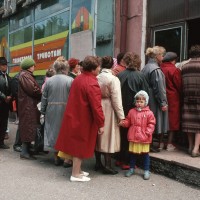The Stage News reports on a trial run of pay-what-you-decide pricing at the regional theatre in Stockton, UK: The Pay What You Decide system is now in effect for all theatre productions at the arts centre for six months, following a trial on a one-man show at the venue. Too Much, Too Young, starring Jack Bennett in January, took nearly 50% more than the theatre expected, with almost one third of the audience new to theatre performances at the ARC. Although the theatre would usually charge £10 for a show such as Too Much, Too Young, … [Read more...]
Who bears the burden of auction house fees, buyers or sellers?
Blog neighbour Lee Rosenbaum writes today about increases in premiums Sotheby's auction house, speculating that Christie's will soon follow suit. She writes: Here are Sotheby’s new charges (with old ones in parentheses), effective Feb. 1: Buyers will be charged 25% of first $200,000 (previously $100,000) of the hammer price; 20% of amount above $200,000 to $3 million (previously above $100,000 to $2 million); 12% of excess over $3 million (previously $2 million). Let’s look at a specific example of how this will work: If your winning bid … [Read more...]
The benefits of price discrimination
An interesting piece in The Guardian today on the design and pricing of seating in theatres, that the efforts to make all seats 'good' seats has made it more difficult for those on a budget to attend performances. Iain Mackintosh writes: We need to unravel the connection between seat prices and auditorium design. In the first theatre building boom, at the end of the 18th century, hundreds of playhouses were built with a top-to-bottom price ratio of eight to one. In the second, at the end of the 19th century, many more were built, including the … [Read more...]
New research from the NEA
New research on arts participation and economics has been released by the National Endowment for the Arts. I won't try to summarize everything there, just a few comments: Two of the reports are on participation: one asks about who participates in what, the other asks people about why they participated. The data will be interesting for researchers willing to dig: what relationships are buried in those survey numbers beyond what is on the surface? I see each of these reports as a spark to future studies. For example, although the … [Read more...]
Enjoying the benefits of old money
I don't disagree with the assessment by Alec MacGillis at Slate that that rust-belt cities offer fine high culture opportunities at low prices: riches from the turn of the last century provided capital (physical, human, institutional) that created great organizations, that can, at least for the time being, survive on endowment funds and relatively low amounts of 'earned income'. But my reaction is somewhat similar to the one I had reading Christopher Knight's recent piece arguing that museums ought to be 'free' - i.e. that the heavy costs of … [Read more...]
Explainer: How do costs affect ticket prices?
Suppose the costs of putting on a show fall - this could be from falling rental rates for performance spaces, technological changes that reduce costs of lighting or sound, or falling labor costs (perhaps through policy changes that lower the cost of providing health insurance to employees). How will this affect ticket prices? In the short run, not at all. In the long run, ticket prices will fall. Let me define 'short run' as the time period over which the production schedule for the company is set: the performance dates for the rest of the … [Read more...]
Price discrimination in the air
Two articles this week on price discrimination by airlines, both written in the context of how crummy the low-priced options are. Slate's Alison Griswold writes: In a paper published last summer on strategic consumer behavior, a pair of researchers found that advance, online purchases of discounted airline tickets were disproportionately made on higher-cost carriers. The finding, they wrote, “suggests that fares at the lowest percentiles are often sufficiently low regardless of the presence of strategic consumers, and that increased … [Read more...]
Problems with data: measuring diversity
Diversity - in audiences, employees, and boards of trustees - matters to arts administrators, and to researchers who study organizations and societies. But how do we measure diversity? The diversity index is constructed like this: suppose everybody comes from one of four different population groups: Blue, Green, Purple and Red. Let the fraction of the population that is Blue be given by B, the fraction that is Green be given by G, and so on, where B, G, P and R are all numbers between zero (if nobody comes from that group) and one (if … [Read more...]
Should nonprofit museums have free admission because they are tax exempt?
No. But Christopher Knight at the LA Times thinks they should: Yes, every art museum needs multiple sources of revenue. It does cost money to run the place. However, because they are tax exempt, art museums already count the public as a major, indirect source of revenue. Required admission fees add a second hit — a kind of "double jeopardy" — and it is one that falls harder on those who can least afford it. But being tax exempt is not an indirect source of revenue. Exemption from the property tax is one less cost to bear, but all the other … [Read more...]
Dynamic pricing and fairness – Uber in Sydney
The car-sharing service Uber uses dynamic pricing (also called surge pricing): prices rise in response to local excess demand (where the demand for rides at the current price exceeds the supply of cars), and fall in response to local excess supply (where there are more cars available at the current price than there is demand for them). Uber's sharp increase in prices in Sydney, where there was a sudden significant excess demand for cars as the result of a downtown hostage taking, has sparked a debate on the morality of dynamic pricing. It's not … [Read more...]









